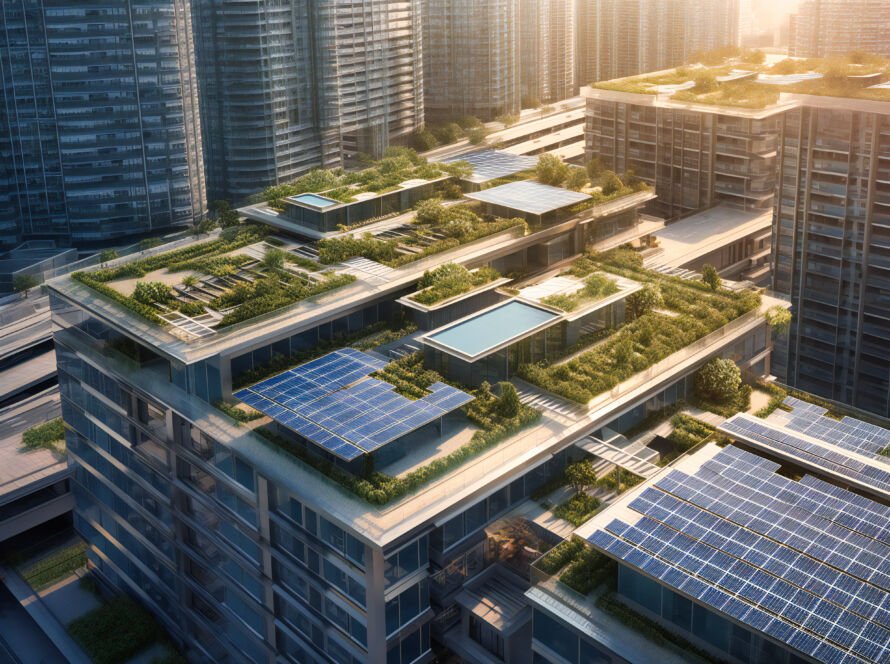In the bustling heart of cities, where skyscrapers stretch skywards and every inch of space is at a premium, the integration of solar energy presents both a compelling opportunity and a formidable challenge. As urban populations swell, the demand for sustainable energy solutions intensifies. Solar power, with its promise of clean, renewable energy, stands at the forefront of this transition. However, the spatial constraints inherent to densely populated areas necessitate innovative approaches and cutting-edge technologies to maximize efficiency and sustainability.
Urban environments are significant consumers of energy, with cities accounting for over 70% of global CO2 emissions. As we grapple with the realities of climate change, transitioning to renewable energy sources is paramount. Solar energy, abundant and ubiquitous, offers a tantalizing solution. But how can cities, characterized by limited space and diverse architectural landscapes, strategically integrate solar power?
1. Rooftop Revolution
One of the most straightforward approaches to integrating solar energy in urban areas is through rooftop solar panels. According to the National Renewable Energy Laboratory (NREL), the potential for rooftop solar power in the U.S. alone is nearly 1,118 gigawatts of capacity, enough to power 25% of the country’s energy needs. Cities like New York and Los Angeles are already making strides in this area. New York’s Solarize NYC program, for instance, aims to expand access to solar through community-driven group purchasing campaigns, reducing costs and making solar more accessible.
However, rooftop space is often limited and unevenly distributed. In response, innovative solutions are emerging. One such advancement is the development of lightweight, flexible solar panels that can be integrated into existing building materials. Companies like Tesla and SunTegra are pioneering solar roof tiles, which seamlessly blend with traditional roofing materials, providing a dual function without compromising aesthetics.
2. Building-Integrated Photovoltaics
As cities grow vertically, so too must our solar solutions. Building-integrated photovoltaics (BIPV) offer a promising avenue for solar integration in urban environments. BIPVs replace conventional building materials in parts of the building envelope, such as facades, windows, and skylights, with photovoltaic materials that generate electricity.
A notable example is the SolarWindow project, which aims to turn skyscraper windows into solar panels. This technology, developed by SolarWindow Technologies, uses transparent solar coatings that can be applied to glass surfaces, transforming windows into energy-generating units. According to the company, a single installation on a 50-story building could generate as much energy as 10 to 12 acres of solar panels.
3. Maximizing Efficiency with Smart Grids
Integrating solar energy into urban environments is not just about installing panels; it’s also about optimizing the energy they produce. Smart grid technology plays a crucial role in this regard. Smart grids use digital communication technology to detect and react to local changes in usage, improving efficiency and reliability. They facilitate the integration of various energy sources, including solar, and enable better energy storage and distribution.
Cities like Amsterdam are at the forefront of smart grid implementation. The Amsterdam Smart City initiative includes projects that integrate renewable energy sources into the city’s grid, enhance energy storage solutions, and promote energy-sharing among residents. These advancements ensure that solar energy, once harnessed, is used in the most efficient manner possible.
4. Community Solar and Energy Sharing
In densely populated areas where individual rooftop installations may not be feasible, community solar projects offer a viable alternative. Community solar allows multiple participants to benefit from a single solar array, often located off-site. Participants purchase or lease a portion of the array, and the electricity generated is credited to their accounts.
Washington D.C.’s Solar for All program exemplifies this approach. The initiative aims to provide 100,000 low-to-moderate income households with the benefits of solar energy by 2032, primarily through community solar projects. Such programs not only increase access to solar power but also foster a sense of community and shared responsibility towards sustainability.
5. Innovative Urban Planning and Policy
Urban planning and policy are pivotal in facilitating solar integration. Zoning laws, building codes, and incentives play critical roles in shaping the solar landscape of a city. For instance, San Francisco has mandated that new buildings must have solar panels or solar water heaters. This policy not only boosts solar adoption but also sets a precedent for other cities to follow.
Moreover, urban planners are increasingly considering solar access in their designs. The concept of solar rights, ensuring that buildings have access to sunlight for potential solar installations, is gaining traction. In cities like Barcelona, urban plans now include provisions for solar orientation, ensuring buildings are designed and placed to maximize solar gain.
6. The Role of Artificial Intelligence
Artificial intelligence (AI) is emerging as a powerful tool in optimizing solar energy use in urban settings. AI can predict energy consumption patterns, optimize the placement of solar panels, and manage energy storage systems. Companies like Google’s DeepMind are using AI to increase the efficiency of their data centers, reducing energy use by 40%. This same technology can be applied to urban solar grids, ensuring maximum efficiency and cost savings.
Future Prospects
The future of urban solar integration looks even more promising with advancements in materials science. Solar skins, for example, are a new technology that allows for customizable solar panel designs that blend with building aesthetics. Developed by Sistine Solar, these skins can mimic the appearance of traditional building materials while generating electricity.
Additionally, the concept of solar roadways is being explored, where roads and pavements are equipped with solar panels. This not only generates energy but also serves practical purposes such as heating to melt snow. While still in experimental stages, pilot projects like those in France and the Netherlands show potential for future urban applications.
Conclusion
The integration of solar energy into urban environments is a multifaceted challenge that requires a blend of technology, innovation, and policy. Rooftop solar, BIPVs, smart grids, community solar projects, and AI are all part of the solution. By leveraging these advancements and fostering supportive policies, cities can transform their energy landscapes.
As we move forward, the commitment to sustainable urban planning and the adoption of cutting-edge technologies will be crucial. Solar energy offers a path to a cleaner, more sustainable future, and with strategic integration, cities can lead the way in this global energy transition. The sun is a resource available to all—it’s up to us to harness it efficiently and sustainably.

